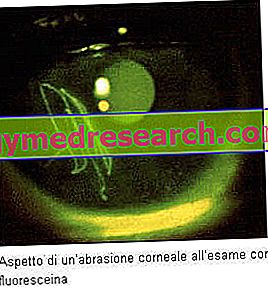Generality
Orthophosphoric acid - more commonly known as " phosphoric acid " - is an inorganic acid having the brute formula H3PO4.

It is an acid used in various fields, the use of which requires a certain caution, especially when it is found in high concentrations. In fact, orthophosphoric acid is a corrosive compound; therefore, although it can be purchased with relative ease, its use requires knowledge of the characteristics of the product and must be carried out by taking appropriate precautions.
What is that?
What is Orthophosphoric Acid?
Orthophosphoric acid is an inorganic triprotic acid (ie with three hydrogen atoms) belonging to the group of oxyacids . Commonly known as phosphoric acid, according to the IUPAC nomenclature (International Union of Pure and Applied Chemistry) this compound is tetraoxophosphoric acid (V).
Phosphoric acid is capable of forming neutral salts, monoacid salts and biacid salts. Furthermore, it is also capable of forming esters (the so-called phosphoric acid esters).
Curiosity
The phosphate group present within the nucleotides that constitute DNA and RNA is a derivative of orthophosphoric acid.
Preparation
Preparation
How to prepare orthophosphoric acid?
Orthophosphoric acid can be obtained through different processes and chemical reactions. At the industrial level, it is produced substantially through two processes: the wet process and the thermal process.
In the wet process, orthophosphoric acid is obtained from the reaction between calcium phosphates and inorganic acids, such as, for example, nitric acid, hydrochloric acid or sulfuric acid. Below is the chemical reaction that involves the use of the latter acid:
Ca3 (PO4) 2 + 3 H2SO4 → 3 CaSO4 + 2 H3PO4
The thermal process, on the other hand, involves obtaining phosphorus pentoxide from elemental phosphorus. Once formed, the anhydride must then be hydrated until orthophosphoric acid is obtained, as shown in the following reaction:
P2O5 + 3 H2O → 2 H3PO4
This last procedure generally gives rise to a purer orthophosphoric acid than the wet process.
Features
Features and Properties of Orthophosphoric Acid
Pure orthophosphoric acid, at ambient temperature and pressure, appears as a white solid that melts at a temperature of about 42 ° C.
However, phosphoric acid is generally marketed in the form of a 85% concentrated aqueous solution. It is a colorless, odorless and non-volatile solution, but corrosive and with a rather dense consistency, almost "syrupy".
Besides being water soluble, orthophosphoric acid is also soluble in ethanol. It is neither explosive nor flammable, but due to its corrosivity to skin and mucous membranes, it must be handled with great care.
uses
What are the uses of orthophosphoric acid?
Orthophosphoric acid is used in many fields, from the medical one, up to the food industry, passing through the chemical industry. However, below are just some of the many applications of this compound.
Dentistry
Orthophosphoric acid is used in dentistry to roughen the surface of the teeth in order to favor the adhesion of cementation materials for capsules, bridges, veneers, fillings, etc. In this context, orthophosphoric acid is generally used in 37% solutions.
Did you know that ...
Orthophosphoric acid is also used in the field of aesthetic dentistry for the application of the so-called brilliant tooth. A practice that has become fashionable for several years now. The motivation that drives the use of orthophosphoric acid in this context is the same for which the compound is used in "classical" dentistry: the acid must roughen the surface of the tooth in order to favor the cementation of the diamond.
Agriculture and Gardening
Orthophosphoric acid can be used in agriculture and gardening as a fertilizer. Not surprisingly, it is part of the composition of various chemical fertilizers.
Food industry
Orthophosphoric acid and its derivatives are also used in the food industry, where they are mainly used as acidifying agents and acidity correctors .
In particular, it is used in numerous carbonated soft drinks, such as the well-known Coca-Cola®, but can also be found inside frozen foods or in cheese-based products. On the label, it is indicated with the abbreviation E338 .
Did you know that ...
Given the presence of orthophosphoric acid in various types of carbonated beverages, many dentists advise against brushing teeth immediately after consumption. This is because the corrosive action of the acid in question combined with the rubbing exerted with the toothbrush can increase the risk of damaging tooth enamel. For this reason, generally, it is advisable to wash the teeth after about half an hour from the consumption of drinks containing very acidic substances.
Chemistry
In the chemical field, orthophosphoric acid is used to carry out analyzes and reactions of various types, both at the industrial level and within research laboratories. For example, it is used in the production of hydracids.
Textile industry
Orthophosphoric acid is also used in the textile industry, where it is used in some processes to dye or fix the color in fabrics such as hemp, cotton and silk.
Other Uses
Among the other uses of orthophosphoric acid, we recall the use as anti-rust (in the form of gel) and the use in the construction field, at which level it is used to descale terracotta surfaces, porcelain stoneware and clinker.
Disposal
How should Orthophosphoric Acid be disposed of?
As a chemical substance, orthophosphoric acid is generally considered as a special waste that must be disposed of in accordance with current legislation. For this reason, it must not be discharged into the sewers or even dispersed in the environment.
In case of doubts concerning the disposal of orthophosphoric acid, therefore, it is necessary to contact specialized companies, or it may be useful to contact your supplier of waste management services.
Safety
As with all chemicals, when orthophosphoric acid is marketed, the manufacturer must make sure to provide the product safety data sheet ( SDS ). This card contains useful information concerning the type of compound sold, its concentration, the chemical-physical properties and all the precautions and precautions that must necessarily be taken to handle and dispose of the product. At the same time, the indications to be followed in the event of accidental spillage and the first aid measures to be taken in the event of contact must also be reported.
Among the different information that must be reported in the aforementioned card and on the label, we find the classification of the product based on the EC regulation 1272/2008. In detail, on the label must be present the special hazard pictogram, accompanied by warnings and indications about risks and dangers related to the use of the product.

In the specific case of orthophosphoric acid, the pictogram is the one shown in the figure and must be accompanied by the corresponding danger indications :
- H314: Causes severe skin burns and eye damage.
and the corresponding precautionary statements :
- P260: do not breathe dust / fumes / gases / mist / vapors / aerosols.
- P303 + P361 + P353: in case of contact with the skin (or hair), immediately remove all contaminated clothing. Rinse the skin / take a shower.
- P305 + P351 + P338: in case of contact with eyes, rinse thoroughly for several minutes. Remove any contact lenses if it is easy to do so. Continue to rinse.
- P301 + P330 + P331: if swallowed, rinse mouth. DO NOT induce vomiting.
The classification according to Directive 67/548 / EEC or Directive 1999/45 / EC is often reported on the safety data sheet. In this case, the pictogram is similar to the one shown in the figure, but is surrounded by a rectangular border and is on an orange background. This pictogram is accompanied by the abbreviation " C " (Corrosive) and the risk phrase " R34: Causes burns ".
Precautions
Precautions and precautions for Use and Conservation of Orthophosphoric Acid
As mentioned, orthophosphoric acid is normally sold in the form of a 85% concentrated aqueous solution. Given its corrosive power, this compound must be handled with care by technically qualified persons and must be stored correctly in order to avoid accidents of any kind.
Below are some tricks and precautions that must be taken before, during and after using the product.
- Wear suitable protective clothing (such as, for example, nitrile rubber gloves, gown or overalls, protective glasses, mask, etc.).
- Do not handle the product near drinks and food intended for both humans and animals.
- After using the product, close the container tightly and store it in a cool, dry place.
- The preservation of orthophosphoric acid must take place away from strong bases with which it could react. Furthermore, the product must not be stored in contact with oxidizers.
Please note
The use of adequate protective clothing is essential during the use of orthophosphoric acid. Because of its corrosive action, in fact - especially when used at high concentrations - orthophosphoric acid can cause very serious damage and burns to the skin and mucous membranes it comes into contact with. If accidentally ingested, this compound can cause corrosion of the oral cavity and pharynx and may even cause perforation of the esophagus and / or stomach.
First aid
Useful First Aid Advice for Contact with Orthophosphoric Acid
Since it is a corrosive substance that can cause severe burns to the skin and mucous membranes, in case of contact with orthophosphoric acid - even more so if very concentrated - it is necessary to immediately contact the doctor or medical help.
However, here are some useful first aid tips to put into practice in the unfortunate event that you should come into contact with orthophosphoric acid.
- In case of contact with clothes, remove them immediately and wash the body with plenty of water and soap, rinsing carefully. Before any re-use, clothing that comes into contact with orthophosphoric acid must be thoroughly washed in order to completely eliminate the substance.
- In the event of contact with the skin, immediately wash with water and soap and rinse thoroughly.
- In the event that the orthophosphoric acid comes into contact with the eyes, wash immediately with plenty of running water, taking care to keep the eyelid open (in the laboratories and in the industries there are special emergency eyewashes for this kind of situation). Then consult a doctor immediately.
- If swallowed, immediately rinse your mouth with water but DO NOT induce vomiting. In the meantime, contact health assistance.
Regardless of the concentration at which orthophosphoric acid is found and regardless of the type of contact that occurs with the substance (with clothes, skin, eyes, mucous membranes, etc.), the speed with which it intervenes is of fundamental importance to limit as much as possible the damage that may result.



